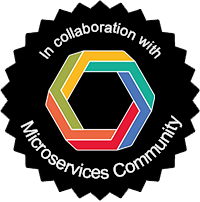Program
June 14th - Single session from 15:00 to 20:00 CEST on Zoom
|
15:00 15:05 |
Opening
Chairs: Filipe F. Correia (UPT), Florian Rademacher (FHDO), Rebecca Wirfs-Brock (Wirfs-Brock Associates), and Blagovesta Kostova (EPFL) The chairs welcome all attendees at AMP 2021 and provide information on the organisation of the event |
|
15:05 16:30 |
Keynote - Rip It Up And Start Again
Speaker: Sam Newman Much of the attention for microservice architectures tends to focus on the technical aspects. But when you look into the details of organisations that have benefited from this approach you realise that there is more to getting the most out of microservices than lots of shinny new technology. In this talk, Sam will show how organisational structures and team responsibilities may need to change if you want to get the most out of adopting a microservice architecture. Looking at traditional IT structures and comparing them with the modern autonomous delivery teams, he’ll explore how to get the organisation and architecture working well together. From Conway's law to Dunbar's number, stream-aligned to two pizza teams, you'll see how you can start to apply these ideas inside your own company. |
|
16:30 17:00 |
Break
|
|
17:00 17:30 |
 A service mesh for collaboration between geo-distributed services: the replication case
A service mesh for collaboration between geo-distributed services: the replication case
Authors: Marie Delavergne, Ronan-Alexandre Cherrueau, and Adrien Lebre Edge computing is becoming more and more present, with edge infrastructures geo-distributed around the globe. These infrastructures must be able to manage the latency and disconnections inherent to their distribution. In parallel, the behavior of cloud applications is getting more complex to apprehend as they are composed of a lot of small services, which serve each a defined purpose. To manage these applications more easily, service meshes handle communications between services and offer different features such as service discovery or traffic monitoring. We believe that service meshes are an opportunity to create a service dedicated to manage the geo-distribution of applications. To do so, we created scope-lang, a language that allows DevOps to specify precisely where a request will be executed. By reifying the location of application instances in requests and allowing redirections between these requests thanks our service and some service mesh functionalities, we make possible three types of collaborations between services. This paper focuses on the replication of a resource on different services instances across different sites and presents Cheops, the service to manage geo-distribution. |
|
17:30 18:00 |
 Towards Integrating Blockchains with Microservice Architecture Using Model-Driven Engineering
Towards Integrating Blockchains with Microservice Architecture Using Model-Driven Engineering
Authors: Simon Trebbau, Philip Wizenty and Sabine Sachweh Blockchain (BC) presents a feasible method to persist immutable information in a distributed ledger to improve the level of authentication and trust. Moreover, smart contracts enable the automated execution of any contract concluded between participants of the Blockchain network. On the other hand, Microservice Architecture (MSA) is a novel approach towards service-based scalable applications. In our paper, we present an agile approach based on Model-Driven Engineering (MDE) that aims to facilitate the integration process of Blockchains into MSA-based applications in order to benefit from the advantages attributed to Blockchains. |
|
18:00 18:30 |
 Implementation of a microservice-based certification platform
Implementation of a microservice-based certification platform
Authors: Sebastian Copei, Manuel Wickert and Albert Zündorf The digitalization of the energy sector is a transformation process to support the decarbonization of the energy system. One of the big challenges for the digitalization in the energy system is the connectivity to edge devices (e.g. e-mobility, heat pumps, PV, etc) for different vendors. Therefore interoperability between different edge devices, back-end systems, and local energy management components is important. In the Horizon 2020 project interconnect interoperability between such smart devices in the energy sector will be examined. Therefore standardized communication protocols will be used and edge devices will be certified to prove compatibility with the standard. Here we will present a microservice-based certification platform to enable certification in agile software development processes. |
|
18:30 19:00 |
Break
|
|
19:00 19:45 |
Keynote - Evolving Monoliths to Microservices
Speaker: Joseph Yoder & Paulo Merson Many Microservices architectures start from the evolution of a Monolith system by gradually applying the microservices architectural style. There are considerations and principles that assist with successfully evolving from a monolith to Microservices. Deciding what to decouple along with when and how to incrementally evolve a system are the main architectural challenges in this process. There are good principles that help with this evolutionary process. For example, it is important to commit to "stop adding to the monolith" - all new code is added as microservices. The new features are microservices, occasionally replacing part of the monolith. Also, there might be important pieces of the monolith that are getting hard to maintain and you want to pull these out. When this happens, you find design seams within the monolith, which can be refactored out to components that can ultimately be replaced with microservices. This is the core of the "Strangler Pattern". Beyond the strangling of a monolith, there are other considerations for organizations that make the strategic move to microservices, such as operational readiness and technical skills. Early on, it is ok to create macro services first and then evolve (refactor) them to microservices. Also, when writing new microservices code, it is important to avoid dependencies to the monolith. This talk will examine various scenarios when evolving from the monolith to microservices specifically with variations of the Strangler Pattern. |
|
19:45 20:00 |
Closing
Chairs: Filipe F. Correia (UPT), Florian Rademacher (FHDO), Rebecca Wirfs-Brock (Wirfs-Brock Associates), and Blagovesta Kostova (EPFL) The chairs close the AMP workshop and provide other informations. |

